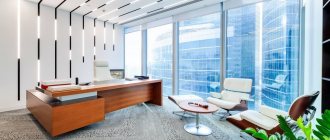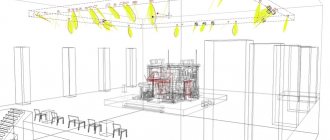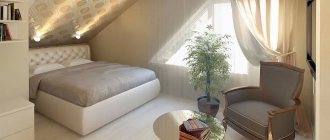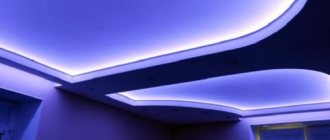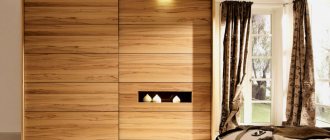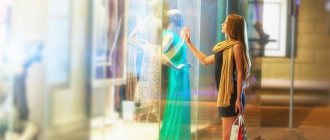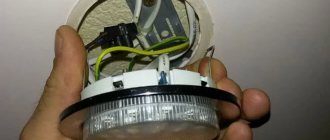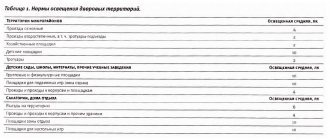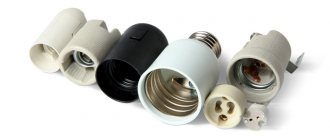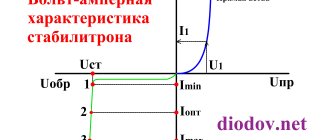It is difficult to meet a person who does not understand the measures of length, area, volume, and weight. It is not difficult to calculate time or determine temperature. But if you ask someone about photometric quantities, then in most cases you cannot expect a clear answer. Meanwhile, we live in constant contact with lighting, natural or artificial. This means that we must learn to evaluate it in some way.
Illumination is...
Of course, such an assessment is always made by everyone, but most often - purely at the level of subjective perception: is there enough light or not. However, such a “gradation” is precisely subjective and can produce significant errors. The consequences of such incorrect assessments cannot be underestimated - both insufficient lighting and its excess negatively affect both a person’s visual organs and his psycho-emotional state.
Meanwhile, there is a special value - illumination, the value of which is regulated by legislative acts in the field of construction and sanitation. That is, illumination is precisely the quality criterion that allows you to correctly evaluate the organization of a room lighting system. In this article we will talk about this parameter and other photometric quantities associated with it, and see how this can be used in a practical application.
Workplace lighting - definition and impact on people
Illumination is understood as a luminous value equal to the ratio of the light flux incident on a certain area of the surface to the area of this area.
Important! Properly organized lighting is especially important for production facilities, offices, warehouses, and workshops. Excessive and insufficient light availability has a negative effect on employees.
According to regulations, in buildings and in production, the distribution of light must be optimal for effective performance of duties.
The efficiency of workers depends on proper lighting, because light affects all components of this indicator:
- energy, endurance, performance;
- work motivation;
- health, good physical well-being.
With a lack of light, people's vision will inevitably decline, chronic overwork and fatigue will occur, and they will lose interest in the results of their work. With too much light, the eyes also get tired and dizziness occurs, especially when subsequently entering a room with less bright lamps. The result is irritability, bad mood, decreased performance, and inattentiveness of employees.
The need to measure illumination
According to hygienic standards, the main indicator of illumination of a space is measured in lux (Lx). In some standards, the unit of measurement is Lumen/square meter of area, which is essentially equal to lux.
Why is artificial lighting measured? For example, office workers who work at a computer every day have a constantly increased visual load. If the light in the office is uneven and falls on the table from the wrong direction, health problems will arise. According to standards, the luminous flux on a PC table must be 300-500 Lux. Carrying out the necessary measurements will allow you to quickly identify deviations in lighting.
Light control
To regulate this issue, building codes and regulations (SNiP) are used - a set of documents that contains all the necessary data and includes four parts:
- general provisions;
- design standards;
- rules of conduct and acceptance;
- estimate rules and regulations.
There are also a number of epidemiological documents - SanPiN, which also regulate the issue of types of lighting, standards and basic requirements for organizing the workplace. SanPiN requirements are also taken into account when developing SNiP and technical documentation. SanPiN applies to both existing industrial and office premises, as well as those being designed or under construction.
Documents on workplace lighting
What lighting should be like in the workplace is reflected by SNiP 05/23/95. There are all the requirements for lighting: natural, artificial. The federal document must be taken into account for old, newly created jobs when redeveloping them.
Another regulatory document on lighting is SanPiN 2.2.4.3359-16. Here are the basic hygiene requirements for business entities. The legislative act also contains requirements for light sources in schools and kindergartens, because the health of schoolchildren and young children depends on lighting.
Various industry standards have also been developed, but they all take into account the provisions of the above documents. Some enterprises additionally use the European Union standard EN 12464, which provides for the use of slightly more intense light fluxes.
The difference between illumination and luminous flux
It is extremely easy to explain the difference between these concepts by comparing them with simple physical quantities: pressure and force. Using a small object (a needle) you can create a lot of pressure with a minimum of force. The same is true with light flux. Using a light bulb that provides low illumination, but concentrating the luminous flux in a limited area, you can achieve local illumination tens of times greater than the general one.
It should be remembered that illumination and luminous flux are measured in different units:
- illumination – lux (lx);
- luminous flux – lumens (lm).
Types of lighting
There are different classifications of lighting. So, according to localization, it can be of the following types:
- General. Assumes uniform lighting of the room without the presence of dark or lighter areas. The presence of only such lighting is usually observed in areas where the work process is carried out part-time.
- Local. Local lighting helps to additionally illuminate certain work areas: a computer or school desk, equipment and machines. It involves the installation of various lighting fixtures in close proximity to the workplace.
According to the standards, the use of exclusively local lighting is unacceptable, since there will inevitably be differences in light in the room - from deep darkness to bright light. This will cause vision problems for workers. Based on light sources, lighting is also divided into several types.
Natural
Natural lighting is created by the forces of nature: direct sunlight, as well as diffuse (reflected) light from the sky. The lack of natural light is unfavorable for a person, because it is to it that the eyes are best adapted. Such light depends on the time of year and period of day, this is its main drawback. But the quality and volume of incoming natural light also depends on the design of the building, the number and size of windows.
Worth knowing! Natural light is measured by KEO - natural light coefficient. It is equal to the ratio of illumination in a building and illumination in an open area in clear weather. There are more KEOs in the southern regions than in the northern ones.
There is even a special light climate map, consisting of 6 zones, according to which windows in buildings should be designed. Natural light is divided into the following types:
- upper (light penetrates through openings in areas with differences in height of the house);
- side (light enters through the windows of the external walls);
- combined (combination of the two previous types).
Artificial
Without artificial lighting at twilight, on a cloudy day or in winter, when it gets dark early, normal work processes are impossible. Additional light sources include lamps, lamps, floor lamps, sconces and other electrical appliances. Usually, halogen and LED lamps are purchased for offices and production. Conventional incandescent light bulbs are now rarely used, since they waste a lot of electricity and quickly break down.
Most often, lighting is mixed, when natural is combined with artificial. The latter is also divided into the following types:
- Working. Regular lighting, which is used daily by employees, helps ensure the workflow.
- Emergency. It turns on only in case of an accident, in an emergency situation, when the main lighting is turned off.
- Evacuation. It is used to illuminate evacuation routes for people in emergencies; it is usually not as powerful as a working one.
- Security. Used by security personnel, it is not present at all enterprises, but when necessary. Not standardized by intensity.
- On duty. Remains on even after the end of the work process (for example, small lighting of corridors in large buildings).
Surface reflectance
Comfortable conditions for office employees also depend on the ability of surfaces to reflect light. Here they take into account the glare that comes from not only lamps, but also furniture, as well as decoration.
The following reflection coefficients are considered optimal for different surfaces:
- walls – 0.3-0.5;
- gender – 0.1-0.4;
- ceiling – 0.6-0.8;
- working surfaces – 0.2-0.7.
According to international standards, the degree of gloss of surfaces is reflected by the UGRL discomfort index, which can range from 13 to 28 (measured in increments of 3).
Sanitary and hygienic standards for office lighting
Lighting standards in office premises are also presented in SaNPiN 2.21/2.1.1.1278-03. Recommended values can be found in Table 2 of this document.
It provides the following indicators for offices:
- Natural lighting (KEO, en) is 3.0 with overhead or combined lighting and 1.0 with side lighting.
- The KEO indicator for combined lighting is 1.8 for combined or overhead lighting and 0.6 for side lighting.
- Artificial illumination is 400 lux for combined lighting and 300 lux for general lighting.
- The discomfort index M cannot exceed level 40.
- The permissible light pulsation coefficient is no more than 15%.
The coefficient of natural illumination (KEO), measured in%, shows the ratio of the amount of natural light indoors to the illumination of a horizontal surface outside, i.e. outdoors in the open air. KEO allows you to control the level of natural light in the office. This is the light that penetrates through windows and other openings in the room, for example, through the second light (openings in the upper part of the building). When KEO indicators are insufficient, artificial lighting is provided in addition to natural light.
Lighting standards and requirements
In order to properly regulate lighting, you need to strictly follow SanPiN and other regulatory documents. All requirements can be divided into those related to illumination itself and those related to the quality of light. Requirements common to all industries:
- the illumination is sufficient for each person;
- the employee can adjust the lighting - direct the light in the desired direction, change its intensity;
- In addition to artificial light, there must be natural light;
- all lamps on the ceiling and walls should be of a muted color; the light bulbs do not cause visual discomfort.
Lighting when working on a PC
Long, daily work with a computer often causes decreased vision in employees. Such problems can be eliminated or slowed down by following the rules and recommendations:
- luminous flux - 300 Lux;
- the brightness of elements in lighting devices is less than 200 cd/sq.m.;
- natural light coefficient (NLC) - from 1.2%;
- location of the window on the side of the work area;
- the presence of individual lighting devices in combination with general ones, if the latter are not enough;
- location of local light sources to the right of the screen;
- no glare on the monitor;
- uniform distribution of the light beam across the table and monitor.
Reflectance coefficients of surrounding surfaces
Reflection from surfaces is an important indicator when organizing a workplace. Surface reflectance refers to the ability of a substrate to reflect incident light. It is equal to the ratio of light reflected from the surface to the total incident luminous flux. Such coefficients have been calculated for a long time (depending on the material, the numbers may vary):
- gender - 0.2-0.4;
- walls - 0.5-0.8;
- ceiling - 0.7-0.9;
- table, work surface - 0.2-0.7.
Industrial lighting standards
There are certain recommendations for standardizing lighting in industrial premises. They vary greatly depending on the accuracy and complexity of the work. For example, for a seamstress, a loader and an assembler of small electrical products, the standards are completely different. In production, the organization of workplaces is subject to the following requirements:
- absence of static and dynamic shadows at the place of work (they are a factor in injury);
- absence of glare, reflected glare, excessive brightness that blinds employees;
- stable, non-blinking backlight;
- correct color rendition of light bulbs;
- physical strength of devices, their resistance to vibration, wear resistance.
Lighting standards for different manufacturing industries:
| Rank in visual work | Characteristics of work | Illumination, Lux (depending on subcategories a, b, c, d) |
| 1 | Highest precision | 400-1250 |
| 2 | Very high precision | 300-750 |
| 3 | High precision | 200-500 |
| 4 | Medium accuracy | 200-300 |
| 5 | Low accuracy | 200-300 |
| 6 | Rough | 200 |
| 7 | Work Observation | 20-75 |
Subcategories reduce the illumination standard. So, with subcategory a - constant work, it is higher, it further decreases with subcategory b (constant stay in the premises with periodic work), c (periodic stay at work and periodic work), d (monitoring communications, equipment).
Industry standards for artificial lighting
In addition to SNiP information, which is general, there are a number of industry documents developed by special institutes. They are established depending on the type of industry after analyzing its specifics, and only then become recommendations. In the absence of specific industry standards, you will have to use general ones.
All industry standards depend on the accuracy of visual work, which is divided into 7 categories depending on the size of the work object and the complexity of the work. For example, precision work (grades 1-4) implies the presence of an object measuring from 0.15 mm (highest accuracy) to 5 mm (average accuracy). The fifth category (low accuracy) may include work with luminous objects.
When dividing work by complexity within a category, the background color is taken into account, because it affects the reflection coefficient (for example, black color has the lowest reflection coefficient). The standards must take into account the following factors:
- duration of work;
- labor intensity;
- degree of task resolution - discrimination or search;
- number of objects in the field of view;
- age of employees;
- qualifications of employees.
Which light is better - natural or artificial?
A comparative assessment of natural and artificial light obtained in the course of research shows a clear advantage of the first. The reason lies in the spectral composition of radiation and the dynamism of natural light, which affects circadian rhythms. But it is impossible to rely only on natural light - a person needs light 4-8 hours longer than the daylight hours, plus about 20% of workers in industrialized regions work in shifts, including at night.
The optimal brightness level for humans is on average 1000-1500 lux. If daylight is not able to provide these indicators, it is necessary to supplement it with artificial light. It can be general or local, designed for a specific work or recreation area.
Optimal workplace lighting - how to calculate it
To determine the illumination coefficient, you need to apply the following formula:
KO = Luminous flux (Watt)/room area (sq.m.)
In proportion to the increase in area, the efficiency of the light flux decreases.
Organizing a comfortable workplace
Uniform lighting is an important requirement for the workplace. This is important to ensure eye comfort during work, because otherwise, vision will have to constantly adapt to changes in the type of lighting. Adaptation occurs as the size of the pupil, the amount of photosensitive substance, etc. changes.
If you go from a very light room to complete darkness, the eye will take a long time to fully adapt (more than an hour), the reverse process will take 15 minutes.
It is important to know! The smaller the difference between the illumination of the zones, the faster the adaptation occurs, the less harmful it is to vision.
An example of improper lighting is the backlighting of a document on a table and the lack of lighting for a monitor or books, which you also have to look at regularly. The frequent need to adapt causes fatigue and eye strain.
Recommendations for organizing a place of work:
- position facing the window or left side for right-handers, right side for left-handers;
- the location of the lamp is in the same way, above the workplace outside the prohibited angle of 45 degrees;
- avoiding blinding of the eyes by the rays of the lamp reflected from the working surface, legs, base of the lamp.
Visual comfort factors
When decorating the interior of office premises, it is important to take into account the color scheme of the walls, because it affects people differently. It is best to choose pastel colors, as well as greenish and yellow shades that are pleasing to the eye. There are other factors of visual comfort:
- suitable brightness;
- homogeneity of light;
- no glare or flicker;
- desired contrast.
Glare, or strong glare, is bad for the eyes - the property of bright surfaces to worsen contrast and disrupt visual comfort. Light fluctuations also cause eye fatigue; they greatly reduce labor productivity, so they are also unacceptable.
Selecting lamps for workplace lighting
LED lamps are ideal for the eyes. In addition, they are economical, last a long time, consume little electricity with excellent efficiency. Halogen lamps are less preferable, although their color reproduction is also quite good. The downside is that they are very hot and cannot be used in any lighting devices. Fluorescent lamps are also used in production, but the light from them is less suitable for the eyes and is unnatural.
By choosing the right lamp and positioning it correctly, you can be sure of maintaining eye health.
Reflection of surfaces
Significantly affects the comfort of the employee and the reflectance of surfaces in the office space. Not only the glare of lamp shades or furniture is taken into account, but even reflected rays from the walls, ceiling, and floor. The standard recommends the following standards for finishing materials, ensuring the most comfortable level of reflected rays for the eyes.
- on the working surface (table), the optimal coefficient is 0.2 - 0.7;
- for walls - from 0.3 to 0.5;
- for the ceiling, an interval of 0.6 to 0.8 is recommended;
- for floors from 0.1 to 0.4.
According to international standards, gloss or discomfort index (UGRL) is graded on a scale of parameters in increments of 3: 13, 16, 19, 22, 25, 28. And the lower the value, the more comfortable the conditions are considered.
The optimal combination of the above parameters for different types of workspaces is given in the summary table below.
Calculation of room lighting system parameters
Calculation is carried out in 3 ways:
- pointwise. In this case, the illumination is calculated for each light source at each point on the surface. Is the most reliable way;
- using the light flux utilization factor. When calculating, the dimensions of the room (length, width, height) and the degree of reflection of surfaces are taken into account;
- through specific power. The method is approximate. With its help, only the power of the required lighting device is preliminarily established.
An electrical specialist in lighting design selects a lighting system, lamps, and evaluates the coefficients of lighting unevenness, surface reflection and illumination reserve based on standardized indicators of the workplace. After this he carries out the calculations. He determines the number of luminaires by calculating the luminous flux utilization factor and the room index. Then he makes a drawing of the location of the lamps.
Sources
- https://cdelct.ru/object/room/osveshheniyu-ofisa-sanpin.html
- https://clubtk.ru/trebovaniya-k-osveshcheniyu-rabochego-mesta
- https://energonom.ru/svet-i-osveshhenie/normy-osveshhyonnosti
- https://220.guru/osveshhenie/istochniki-sveta/normy-i-trebovaniya-osveshhennosti-rabochego-mesta.html
- https://zoom.cnews.ru/publication/item/63127
- https://svetpro.ru/htm/informations/osvechenie_na_rabote_info15.html
- https://ksosvet.ru/blog/iskusstvennoe-i-estestvennoe-osveshchenie-ofisa-normy-pravila-rekomendacii
- https://1posvetu.ru/svetodizajn/normy-osveshhennosti-ofisnyh-pomeshhenij.html
- https://interalighting.ru/blog/2518_rabochee-mesto
- https://amperof.ru/osveshenie/kak-raschitat-normy-osveshheniya.html
